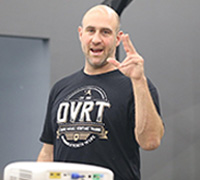The Rib Flare Confusion
- Josh Henkin, CSCS
I consider coaching a bit like being a detective. You are constantly seeking to find why someone is having issues and what the best solutions to those problems would be in their training.

Having been in the industry for over 25 years now, I have seen the “solution” to a multitude of issues in training be proclaimed with the greatest of certainty. Unfortunately, because the results don’t live up to the promise we tend to dismiss those ideas and find the new “real” solution to our problem.
We can see this in the rather new fascination with rib flare concepts. What’s rib flare if you haven’t heard of it before? An easy example if when we go to lift our arms overhead and we see the ribs appear to elevate and greatly expand. What’s the issue though in having such a movement occur?

The most obvious issue is that it changes our spinal position where we could experience more problems due to greater curve in our low back. There are also potential issues that can impact our shoulder mechanics and some believe it is also related to problematic breathing patterns which can cause all sorts of other issues too. Is this true?
Well, I think there is a difference between causes and symptoms. To me, the rib flare could be a symptom to a host of various issues (as are most problems that we try to address). For example, is rib flare just a breathing issue? This 2008 study makes us ask an interesting question in this regards. They looked at people with and without low back pain and their breathing patterns. They did so while at rest and then with very basic movement. What did they find?
At rest, no significant differences were found between the breathing pattern of patients and healthy subjects. In contrast, significantly more altered breathing patterns were observed in chronic LBP-patients during motor control tests. Changes in breathing pattern during motor control tests were not related to pain severity, but were related to motor control dysfunction.” For one, breathing patterns don’t seem to have a huge relationship with perceived pain (we can go down that rabbit hole another time), but also that people with low back pain at rest didn’t have issues with breathing. ONLY when they started to move their body that there was a motor control issue in how they began to breathe. This is theorized to be a motor control issue or we can think of a trunk stability issue.
What does this mean for your training? We coach A LOT in DVRT to use the hands, feet, and being mindful in how we hold any weight that we use (along with being particular in which weight we use). THIS is the a great start in teaching the proper stability and motor control that will prevent issues like rib flare but SO much more!

Coach Robin Paget shows how different our rib and overall body position can be if we just properly cue and be intentional with how we use our hands and feet.
This solution sounds too simple to be real right? It is real and it is simple in theory, not always in practice. As we fatigue, add complexity to a movement, or a host of other reasons that people lose focus on such important keys. However, the more that we can be intentional about these ideas the better and faster results we achieve. In fact, physical therapist, Jessica Bento, does a great job of explaining how simple (not necessarily easy) these ideas can be to implement and where we can start.
Josh Henkin

Josh is an international presenter and strength coach who has taught in over 13 countries worldwide and consulted with some of the top fitness and performance programs in the world. You can check out his DVRT online fitness educational certifications/courses HERE and get 20% off with code “pb20”

